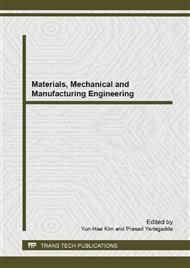p.581
p.586
p.591
p.596
p.602
p.607
p.612
p.620
p.624
Method of Tool Path Optimization in Impeller NC Machining Based on Configuration Space Theory
Abstract:
The impeller as the key part of aircraft engine components, and the impeller blade surface is complex, and it is a typical complex difficult machining parts. Five-axis NC machining is the important means to realize sculptured curved surface parts machined with high quality and efficiency. In this paper, in view of the interference problems occurred in the process of impeller five-axis NC machining tool path generating, the configuration space method is proposed to tackle the problem of interference, cutter location point as constraint conditions, the cutter position is described by using two angle parameters, optimization of cutter position, tool path generated without interference, improve the impeller machining quality and production efficiency. Finally, as a case study of a certain type of impeller, it makes arithmetic realization combining with MATLAB.
Info:
Periodical:
Pages:
602-606
Citation:
Online since:
November 2013
Authors:
Price:
Сopyright:
© 2014 Trans Tech Publications Ltd. All Rights Reserved
Share:
Citation:


